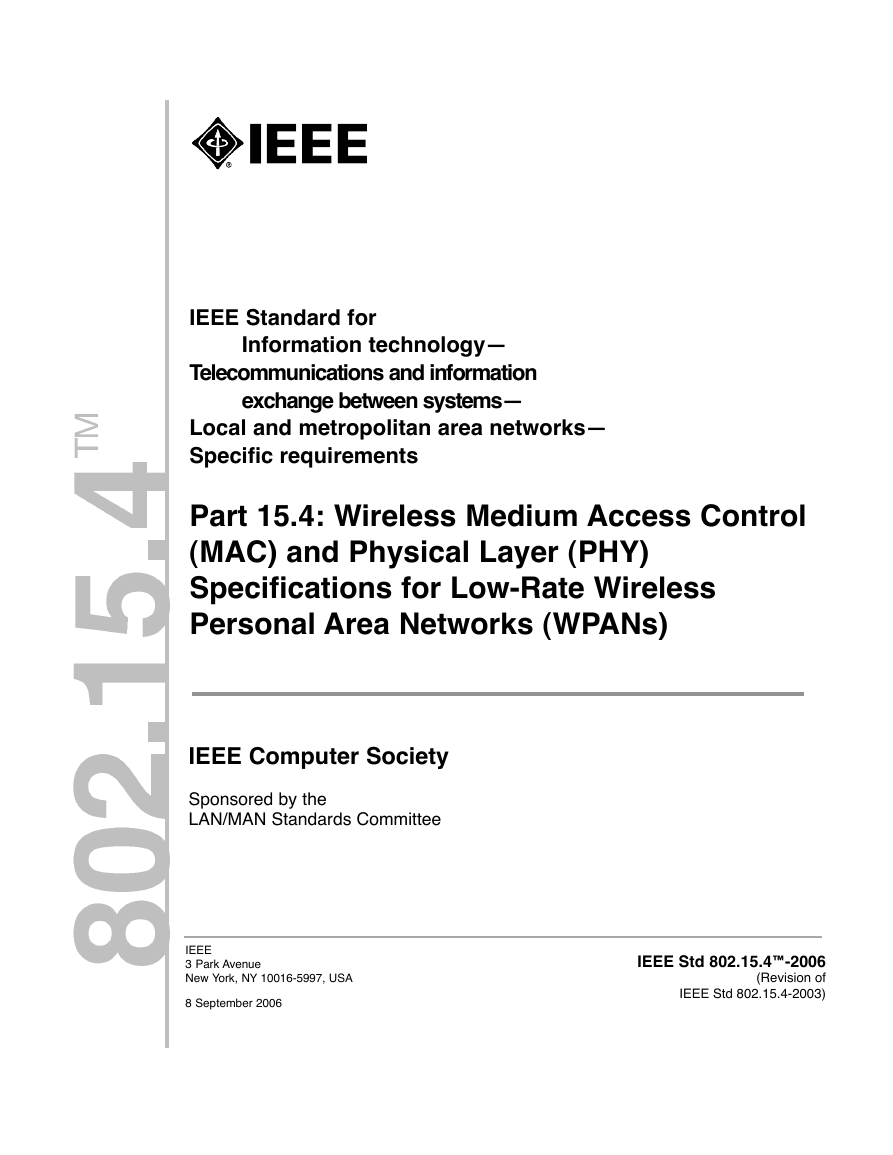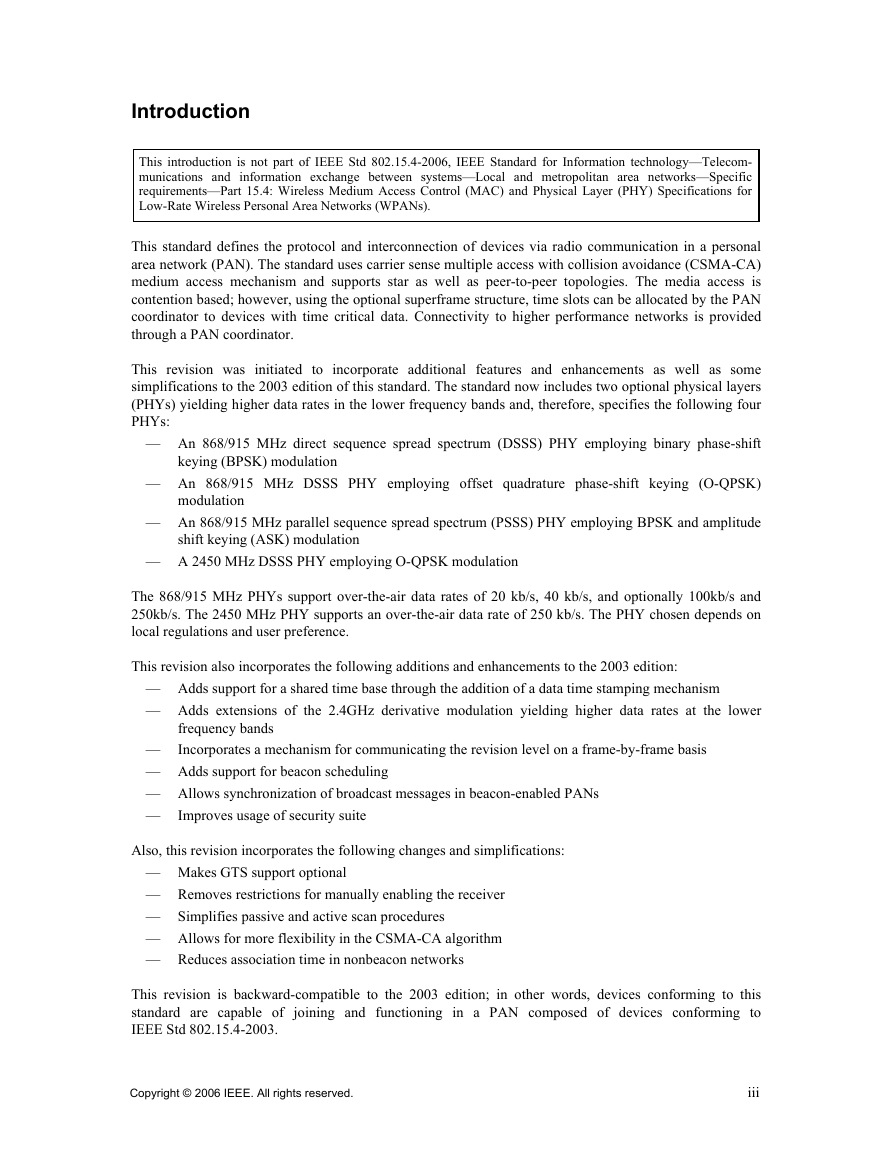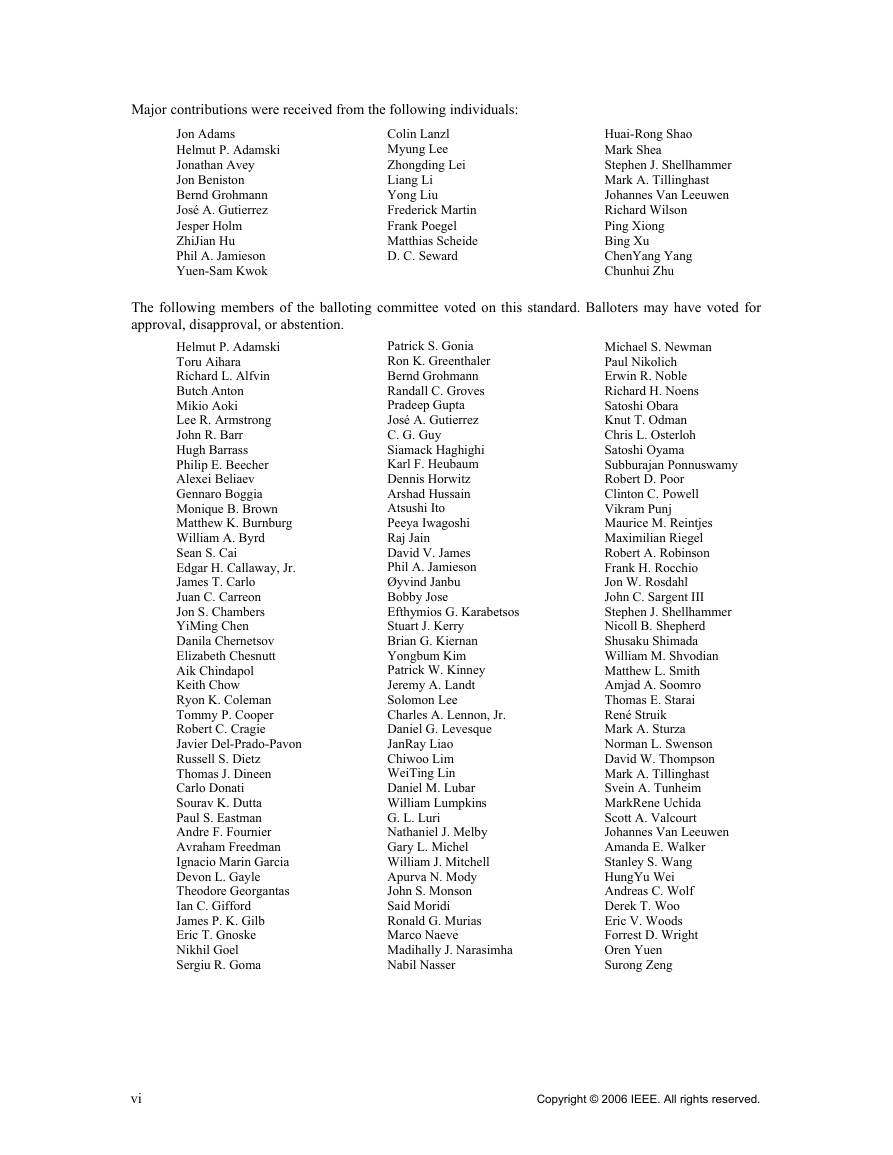IEEE Std 802.15.4-2006 Front Cover
Title page
Introduction
Notice to users
Errata
Interpretations
Patents
Participants
Contents
Part 15.4: Wireless Medium Access Control (MAC) and Physical Layer (PHY) Specifications for Low-Rate Wireless Personal Area Networks (WPANs)
1. Overview
1.1 General
1.2 Scope
1.3 Purpose
2. Normative references
3. Definitions
4. Acronyms and abbreviations
5. General description
5.1 Introduction
5.2 Components of the IEEE 802.15.4 WPAN
5.3 Network topologies
5.3.1 Star network formation
5.3.2 Peer-to-peer network formation
5.4 Architecture
5.4.1 Physical layer (PHY)
5.4.2 MAC sublayer
5.5 Functional overview
5.5.1 Superframe structure
5.5.2 Data transfer model
5.5.3 Frame structure
5.5.4 Improving probability of successful delivery
5.5.5 Power consumption considerations
5.5.6 Security
5.6 Concept of primitives
6. PHY specification
6.1 General requirements and definitions
6.1.1 Operating frequency range
6.1.2 Channel assignments
6.1.3 Minimum long interframe spacing (LIFS) and short interframe spacing (SIFS) periods
6.1.4 RF power measurement
6.1.5 Transmit power
6.1.6 Out-of-band spurious emission
6.1.7 Receiver sensitivity definitions
6.2 PHY service specifications
6.2.1 PHY data service
6.2.2 PHY management service
6.2.3 PHY enumerations description
6.3 PPDU format
6.3.1 Preamble field
6.3.2 SFD field
6.3.3 Frame Length field
6.3.4 PSDU field
6.4 PHY constants and PIB attributes
6.4.1 PHY constants
6.4.2 PHY PIB attributes
6.5 2450 MHz PHY specifications
6.5.1 Data rate
6.5.2 Modulation and spreading
6.5.3 2450 MHz band radio specification
6.6 868/915 MHz band binary phase-shift keying (BPSK) PHY specifications
6.6.1 868/915 MHz band data rates
6.6.2 Modulation and spreading
6.6.3 868/915 MHz band radio specification
6.7 868/915 MHz band (optional) amplitude shift keying (ASK) PHY specifications
6.7.1 868/915 MHz band data rates
6.7.2 Modulation and spreading
6.7.3 868/915 MHz band radio specification for the ASK PHY
6.7.4 SHR for ASK PHY
6.8 868/915 MHz band (optional) O-QPSK PHY specifications
6.8.1 868/915 MHz band data rates
6.8.2 Modulation and spreading
6.8.3 868/915 MHz band radio specification
6.9 General radio specifications
6.9.1 TX-to-RX turnaround time
6.9.2 RX-to-TX turnaround time
6.9.3 Error-vector magnitude (EVM) definition
6.9.4 Transmit center frequency tolerance
6.9.5 Transmit power
6.9.6 Receiver maximum input level of desired signal
6.9.7 Receiver ED
6.9.8 Link quality indicator (LQI)
6.9.9 Clear channel assessment (CCA)
7. MAC sublayer specification
7.1 MAC sublayer service specification
7.1.1 MAC data service
7.1.2 MAC management service
7.1.3 Association primitives
7.1.4 Disassociation primitives
7.1.5 Beacon notification primitive
7.1.6 Primitives for reading PIB attributes
7.1.7 GTS management primitives
7.1.8 Primitives for orphan notification
7.1.9 Primitives for resetting the MAC sublayer
7.1.10 Primitives for specifying the receiver enable time
7.1.11 Primitives for channel scanning
7.1.12 Communication status primitive
7.1.13 Primitives for writing PIB attributes
7.1.14 Primitives for updating the superframe configuration
7.1.15 Primitives for synchronizing with a coordinator
7.1.16 Primitives for requesting data from a coordinator
7.1.17 MAC enumeration description
7.2 MAC frame formats
7.2.1 General MAC frame format
7.2.2 Format of individual frame types
7.2.3 Frame compatibility
7.3 MAC command frames
7.3.1 Association request command
7.3.2 Association response command
7.3.3 Disassociation notification command
7.3.4 Data request command
7.3.5 PAN ID conflict notification command
7.3.6 Orphan notification command
7.3.7 Beacon request command
7.3.8 Coordinator realignment command
7.3.9 GTS request command
7.4 MAC constants and PIB attributes
7.4.1 MAC constants
7.4.2 MAC PIB attributes
7.5 MAC functional description
7.5.1 Channel access
7.5.2 Starting and maintaining PANs
7.5.3 Association and disassociation
7.5.4 Synchronization
7.5.5 Transaction handling
7.5.6 Transmission, reception, and acknowledgment
7.5.7 GTS allocation and management
7.5.8 Frame security
7.6 Security suite specifications
7.6.1 PIB security material
7.6.2 Auxiliary security header
7.6.3 Security operations
7.7 Message sequence charts illustrating MAC-PHY interaction
Annex A (normative) Service-specific convergence sublayer (SSCS)
A.1 IEEE 802.2 convergence sublayer
A.1.1 MA-UNITDATA.request
A.1.2 MA-UNITDATA.indication
A.1.3 MA-UNITDATA-STATUS.indication
Annex B (normative) CCM* mode of operation
B.1 Introduction
B.2 Notation and representation
B.2.1 Strings and string operations
B.2.2 Integers, octets, and their representation
B.3 Symmetric-key cryptographic building blocks
B.3.1 Block cipher
B.3.2 Mode of operation
B.4 Specification of generic CCM* mode of operation
B.4.1 CCM* mode encryption and authentication transformation
B.4.2 CCM* mode decryption and authentication checking transformation
B.4.3 Restrictions
Annex C (informative) Test vectors for cryptographic building blocks
C.1 AES block cipher
C.2 Mode of operation
C.2.1 MAC beacon frame
C.2.2 MAC data frame
C.2.3 MAC command frame
Annex D (normative) Protocol implementation conformance statement (PICS) proforma
D.1 Introduction
D.1.1 Scope
D.1.2 Purpose
D.2 Abbreviations and special symbols
D.3 Instructions for completing the PICS proforma
D.4 Identification of the implementation
D.5 Identification of the protocol
D.6 Global statement of conformance
D.7 PICS proforma tables
D.7.1 Major roles for devices compliant with IEEE Std 802.15.4-2006
D.7.2 Major capabilities for the PHY
D.7.3 Major capabilities for the MAC sublayer
Annex E (informative) Coexistence with other IEEE standards and proposed standards
E.1 Introduction
E.2 Standards and proposed standards characterized for coexistence
E.3 General coexistence issues
E.3.1 Clear channel assessment (CCA)
E.3.2 Modulation
E.3.3 ED and LQI
E.3.4 Low duty cycle
E.3.5 Low transmit power
E.3.6 Channel alignment
E.3.7 Dynamic channel selection
E.3.8 Neighbor piconet capability
E.4 2400 MHz band coexistence performance
E.4.1 Assumptions for coexistence quantification
E.4.2 BER model
E.4.3 Coexistence simulation results
E.5 800/900 MHz bands coexistence performance
E.5.1 Victims and assailants
E.5.2 Bandwidth
E.5.3 Path loss model
E.5.4 Temporal model
E.5.5 Coexistence assurance results
E.6 Notes on the calculations
Annex F (informative) IEEE 802.15.4 regulatory requirements
F.1 Introduction
F.2 Applicable U.S. (FCC) rules
F.2.1 Section 15.35 of FCC CFR47
F.2.2 Section 15.209 of FCC CFR47
F.2.3 Section 15.205 of FCC CFR47
F.2.4 Section 15.247 of FCC CFR47
F.2.5 Section 15.249 of FCC CFR47
F.3 Applicable European rules
F.3.1 European 2400 MHz band rules
F.3.2 European 868-870 MHz band rules
F.4 Applicable Japanese rules
F.5 Emissions specification analysis with respect to known worldwide regulations
F.5.1 General analysis and impact of detector bandwidth and averaging rules
F.5.2 Frequency spreading and averaging effects specific to IEEE Std 802.15.4
F.6 Summary of out-of-band spurious emissions limits
F.7 Phase noise requirements inferred from regulatory limits
F.8 Summary of transmission power levels
Annex G (informative) Bibliography
G.1 General
G.2 Regulatory documents
















 uCOS-III的任务调度算法研究.pdf
uCOS-III的任务调度算法研究.pdf STM32F103x8B_DS_CH_V10(7STM32中文数据手册).pdf
STM32F103x8B_DS_CH_V10(7STM32中文数据手册).pdf FX2N系列PLC培训教程.pdf
FX2N系列PLC培训教程.pdf Modbus协议资料.pdf
Modbus协议资料.pdf WM8978中文资料(芯片资料).doc
WM8978中文资料(芯片资料).doc 5-1.【Codelab】HarmonyOS基于图像模块实现图库图片的四种常见操作.pdf
5-1.【Codelab】HarmonyOS基于图像模块实现图库图片的四种常见操作.pdf GX Developer 编程软件使用说明.pdf
GX Developer 编程软件使用说明.pdf MR-E伺服与FX3G接线图.pdf
MR-E伺服与FX3G接线图.pdf ATK-NEO-6M GPS模块常见问题汇总_201400721.pdf
ATK-NEO-6M GPS模块常见问题汇总_201400721.pdf STM32F407ZGT6(芯片资料).pdf
STM32F407ZGT6(芯片资料).pdf FM1715编程指南.pdf
FM1715编程指南.pdf Profibus教程-7.PROFIBUS-FMS.pdf
Profibus教程-7.PROFIBUS-FMS.pdf